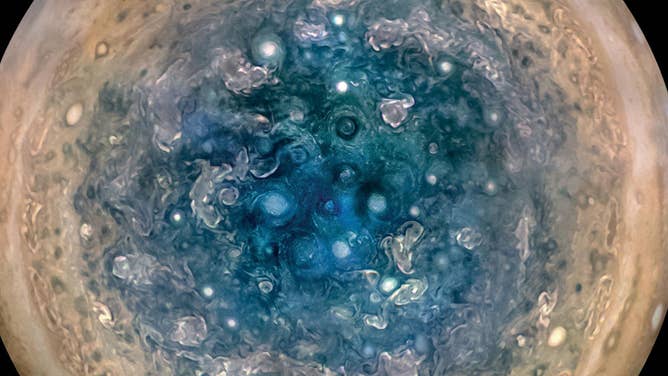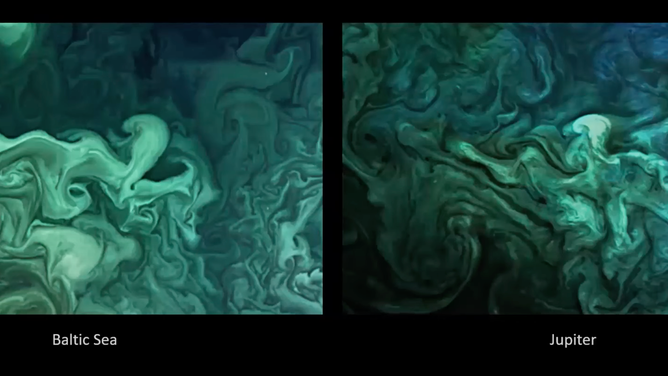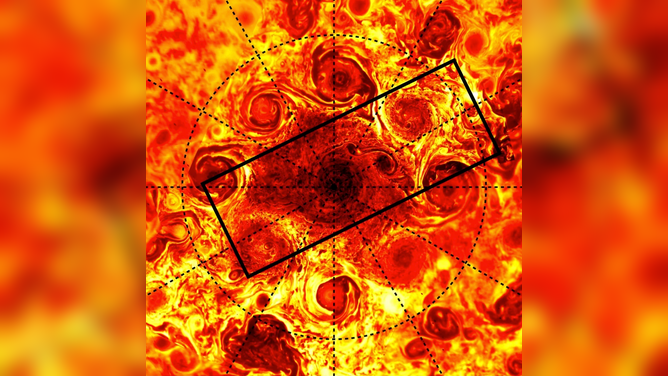Jupiter has striking similarities with Earth's oceans, oceanographers find
Jupiter's turbulent atmosphere undergoes similar process to Earth's oceans

Jupiter's south pole taken by Juno. (Image: NASA/JPL-Caltech)
Jupiter is covered in swirling vortices, the intense radiation would be deadly to humans, and it can't host life as we know it, but yet a NASA spacecraft has been sending back beautiful images of the gas giant, and there is something very familiar about the alien world.
NASA's Juno spacecraft has been orbiting Jupiter for six years capturing color photos with JunoCam that have wowed citizen scientists who have access to comb through the images on the mission website.
Lia Siegelman, an oceanographer with Scripps Institution of Oceanography, was walking on the CalTech campus when she got a glimpse of one of these images. Immediately, it struck her because it looked similar to the ocean currents with phytoplankton that she was studying.
"Whoa, this looks just like the oceans that we can see from space here on Earth," she recalled thinking. "And then we just casually chatted about it. 'Yeah. Must be some, you know, common dynamics."
Later on, after speaking to a planetary scientist about her background in vortex dynamics, they asked her to look at some Juno data. Siegelman studies cyclones around Antarctica and the Southern Ocean and how they interact. Jupiter's atmosphere is also full of powerful cyclones but on a much larger scale. The vortices are about ten times bigger on Jupiter than our home planet.
1 MILLION MILES FROM EARTH, JAMES WEBB TELESCOPE ARRIVES HOME
At the American Geophysical Union fall meeting in December, Siegelman presented her research comparing Jupiter and Earth. Before she began Juno Principal Investigator Scott Bolton presented a video of images taken by JunoCam showing the swirling atmosphere.
"It's really an artist's palette. This is almost like a Van Gogh painting; you see these incredible vortexes and swirling clouds of different colors," he said.

A false color image of Jupiter and the Baltic Sea on Earth. (Image credit: NASA/JPL-Caltech/SwRI)
These kinds of images inspired Siegelman to look deeper because it looked like what she was studying in Earth's oceans. Siegelman said that understanding the systems at play on Jupiter can help us better understand our planet.
Most recently, Siegelman was the lead author on a paper published in Nature Physics describing the forces that drive the enormous cyclones at Jupiter's poles. According to the researchers, moist convection, a process on Earth when water condensates and then forms clouds, fuels the massive storms on Jupiter.
"So Jupiter and (Earth's) ocean, I'm not saying they're the same. They're very different," Siegelman said. "It's just on Jupiter we're able to prove that moist convection, which is the process by which cloud forms on Earth …. we're able to show that this happens on Jupiter. And it's where those large cyclones, five thousand kilometers in diameter, that's where they get their energy from."
It was long hypothesized that Jupiter's cyclones were driven by moist convection, but they finally had the data to prove it with Juno's observations.
The cyclones on Jupiter gain energy from smaller processes becoming stronger as energy is transferred. This is also something that happens in Earth's oceans.
NEW ROCKET IN TOWN: ASTRA SETS LAUNCH DATE FOR FIRST LIFTOFF FROM CAPE CANAVERAL
"Two cyclones, they meet, and they merge. And so the two smaller ones, they become a bigger one," she said. "You can see how energy was in two small structures becoming a larger structure."
Energy in the ocean is constantly ebbing and flowing. Cyclones escape from the Gulf Stream and sometimes merge back again, adding back energy to the larger structure of the Gulf Stream, explained Siegelman.
Juno has also observed an area of six cyclones that appeared in a fixed position, which fascinated Siegelman, so again, she turned to ocean dynamics to explain the process.
"You can see some slight shifts with some of the cyclones, they're oscillating, and they're not exactly fixed," she said. "So in that sense, it's kind of similar and makes sense because Jupiter is a gas, the ocean is fluid, but both, you know, are fluids, and they have to answer to the same laws of physics."

Cyclones at Jupiter's north pole taken in February 2017 by NASA's Juno spacecraft. (Image credit: NASA)
Another study is underway to determine why the group of cyclones at both of Jupiter's poles have not merged. Similar to Saturn, where there is one large cyclone at the pole.
"They're all the same size. They're all cyclones. So you would expect them to merge, to merge into one large cyclone," Siegelman said, adding researchers are trying to find out why the cyclones don't merge into a stable structure as one large cyclone.
Oceanography and planetary science is a growing collaborative field.
NASA has plans to launch a spacecraft to Europa, one of Jupiter's moons, which is thought to have a global ocean under its icy crust. Siegelman hopes to expand her research by looking at the oceans on Europa.
"That would be an oceanographer's dream to study the oceans on an icy moon," she said.
Several oceanographers have even been to space, most recently NASA astronauts Megan McArthur and Jessica Meir, both Scripps Institution of Oceanography alumna.